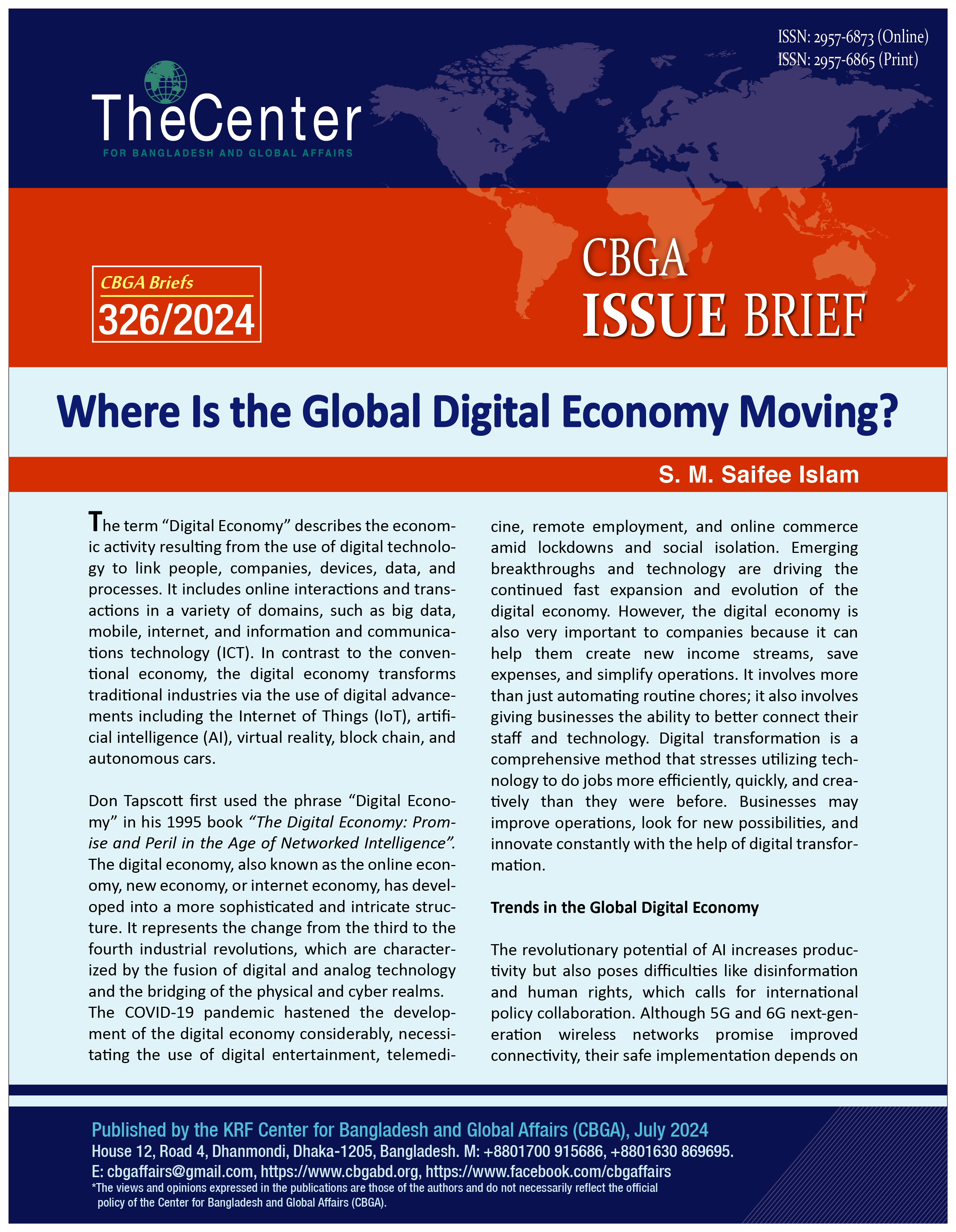
The term “digital economy” describes the economic activity resulting from the use of digital technology to link people, companies, devices, data, and processes. It includes online interactions and transactions in a variety of domains, such as big data, mobile, internet, and information and communications technology (ICT). In contrast to the conventional economy, the digital economy transforms traditional industries via the use of digital advancements including the Internet of Things (IoT), artificial intelligence (AI), virtual reality, block chain, and autonomous cars.
Don Tapscott first used the phrase “digital economy” in his 1995 book “The Digital Economy: Promise and Peril in the Age of Networked Intelligence.” The digital economy, also known as the online economy, new economy, or internet economy, has developed into a more sophisticated and intricate structure. It represents the change from the third to the fourth industrial revolutions, which are characterized by the fusion of digital and analog technology and the bridging of the physical and cyber realms.
The COVID-19 pandemic hastened the development of the digital economy considerably, necessitating the use of digital entertainment, telemedicine, remote employment, and online commerce amid lockdowns and social isolation. Emerging breakthroughs and technology are driving the continued fast expansion and evolution of the digital economy. However, the digital economy is also very important to companies because it can help them create new income streams, save expenses, and simplify operations. It involves more than just automating routine chores; it also involves giving businesses the ability to better connect their staff and technology. Digital transformation is a comprehensive method that stresses utilizing technology to do jobs more efficiently, quickly, and creatively than they were before. Businesses may improve operations, look for new possibilities, and innovate constantly with the help of digital transformation.
Trends in the Global Digital Economy
The revolutionary potential of AI increases productivity but also poses difficulties like disinformation and human rights, which calls for international policy collaboration. Although 5G and 6G next-generation wireless networks promise improved connectivity, their safe implementation depends on regulatory certainty. Disparities are highlighted by the spread of digital technology, which calls for equitable access and skill development.
| General E-Commerce Statistics | Indicators |
| Percentage of retail purchases online (2024) | 20.1% |
| Percentage of retail purchases online (2027) | 23% |
| E-commerce sales growth rate (2024) | 8.8% |
| Global e-commerce market size (2024) | $6.3 trillion |
| Global e-commerce market size (2027) | $7.9 trillion |
| Most visited e-commerce websites | Amazon (2.8 billion views), AliExpress (952 million), eBay (872 million) |
Source: https://www.forbes.com/advisor/business/ecommerce-statistics/
Virtual reality presents industry benefits while posing privacy issues, necessitating wise development tactics. Protective measures are necessary for mental health hazards in digital settings, and international collaboration and evidence-based regulations are essential for maximizing the advantages of digital technology while minimizing its drawbacks.
Expansion of Overall e-commerce
With 2.8 billion internet users and projected business-to-consumer e-commerce sales of over $1 trillion, the global digital economy was booming in 2015. The worldwide e-commerce sector is expected to reach an astounding $6.9 trillion by 2024, growing at a powerful 9.8% annual rate, according to forecasts. The importance of client loyalty has been shown by the remarkable 22-fold increase in customer value. Online buyers are still swayed by the allure of free delivery when making purchases. Remarkably, 75% of online shoppers say that product photographs influence their purchase decisions; nonetheless, a major obstacle still exists, as 70% of online shopping carts are eventually abandoned. Globally, e-commerce has grown at an exponential rate, with Africa emerging as a hub for online shopping. South African platforms such as Glovo and Takealot, which provide everything from groceries to gadgets at the touch of a button, are revolutionizing customer behavior. E-commerce has the potential to transform retail across the continent in 2024 as internet availability spreads.
Impressive Growth Trajectory in Global e-commerce
The worldwide e-commerce business continues to develop rapidly and shows no signs of stopping. Global e-commerce sales increased by an astonishing 8.8% in 2024, making it one of the strongest growth rates expected between 2021 and 2027. Forecasts suggest further increase, with revenues expected to reach $6.86 trillion by 2025, $550 billion more in 2026, and perhaps $7.96 trillion by 2027. This highlights a significant 59.8% growth in revenues between 2021 and 2027, demonstrating e-commerce’s growing profitability and profound influence on global retail marketplaces.
| Mobile E-Commerce Statistics | |
| Online purchases via smartphone | 91% |
| Expected mobile commerce as % of retail sales (2027) | 62% |
| Mobile commerce sales (2023) | $491 billion |
| Expected mobile commerce sales (2027) | $856 billion |
| Tablet m-commerce sales (expected 2026) | $54.01 billion |
Source: https://www.forbes.com/advisor/business/ecommerce-statistics/
Major Actors of Global Digital Economy
China and the United States have emerged as significant participants in the global e-commerce market, accounting for more than $4.1 trillion in sales in 2023. China led with $3,023 billion, fueled by behemoths like Alibaba, while the United States trailed with $1,163 billion, demonstrating powerful consumer markets and sophisticated digital infrastructures. The tremendous impact of these two economic powerhouses continues to drive innovation and competitiveness among the world’s top e-commerce companies.
Furthermore, the fast development in mobile commerce (m-commerce) sales, which are expected to approach $2.5 trillion by 2024, demonstrates the changing dynamics of global retail as mobile technology becomes more integrated into consumer lives.
| Rank | Country | E-commerce Sales (in Billion USD) |
| 1 | China | 3,023 |
| 2 | United States | 1,163 |
| 3 | UK | 195 |
| 4 | Japan | 193 |
| 5 | South Korea | 147 |
| 6 | India | 118 |
| 7 | Germany | 97 |
| 8 | Indonesia | 97 |
| 9 | Canada | 83 |
| 10 | France | 79 |
Source: https://www.dash.app/blog/ecommerce-statistics
Growth of Online Banking and Social Media Shopping
The worldwide online banking industry, estimated at USD 15.20 billion in 2023, is expected to increase significantly with a compound annual growth rate (CAGR) of 14.20% from 2024 to 2033, possibly reaching USD 57.35 billion. Concurrently, the social media industry is expanding rapidly, with a 14.8% annual growth rate from $219.06 billion in 2023 to $251.45 billion in 2024. These trends highlight the rising importance of digital platforms in global communication and consumer behavior.
| Online Shopping Behavior Statistics | Indicators |
| Percentage of online shoppers shopping internationally | 52% |
| Most common reason for cart abandonment | Additional costs (47%) |
| Cart abandonment due to account creation | 25% |
| Abandonment due to slow shipping | 24% |
| Frequency of online shopping (at least once a week) | 34% |
| Online shopping cart abandonment rate | 70% |
Source: https://www.forbes.com/advisor/business/ecommerce-statistics/
| Social Media E-Commerce Statistics | Indicators |
| Total spent on social media commerce (2022) | $992 billion |
| Expected social media commerce size (2030) | $8.5 trillion |
| Most popular social media platform for transactions | |
| Purchases influenced by social media | 40% |
| Influencer impact on purchases | 49% |
Source: https://www.forbes.com/advisor/business/ecommerce-statistics/
Fintech Innovations, and Digital Healthcare Solutions
Fintech innovations are democratizing access to financial services, especially in underdeveloped areas such as Africa. The Digital Economy Program, for example, is promoting financial inclusion via platforms like as M-Pesa in Kenya and Paga in Nigeria, allowing millions of people to trade, save, and obtain credit without the need of conventional banking infrastructure. These improvements are critical for promoting economic empowerment and inclusive growth. Across Africa, the gig economy is booming and providing new job and business possibilities. Websites such as Fiverr, Innovation Village, and Upwork through Maven’s network, people may offer their abilities and services to a worldwide audience, and local platforms like Bolt in Nigeria and SafeBoda in Uganda provide flexible income options through delivery and ride-hailing services.
In healthcare, technological integration is driving the adoption of digital health solutions, especially in Africa’s rural locations. Mobile telemedicine applications, such as Baobab Health in Malawi, let people interact with healthcare professionals, improve access to quality treatment, and reduce healthcare inequities.
The Dangers of the Digital Economy: A Growing Concern That Must Be Addressed
The digital economy is currently facing a critical juncture, with both immense possibilities and significant obstacles ahead. Although digital technologies offer promising advantages across various sectors, they also come with notable risks. The ever-present specter of cybersecurity threats and the growing unease over privacy issues have cast a shadow of doubt, eroding the trust that is vital for a thriving digital ecosystem. These concerns have also deepened existing economic disparities, further exacerbating the challenges we face.
| E-Commerce Fraud Statistics | Indicators |
| Losses due to e-commerce fraud (2022) | $41 billion |
| Expected losses due to e-commerce fraud (2023) | $48 billion |
| E-commerce fraud detection and prevention market size (2021) | $36.7 billion |
| Estimated market size (2027) | Over $100 billion |
Source: https://www.forbes.com/advisor/business/ecommerce-statistics
The presence of social risks, such as misinformation and algorithmic bias, adds complexity to the current landscape, affecting public discourse and fairness. In addition, the prevalence of digital technology in today’s society has raised concerns about its impact on mental health, especially among young people who engage in excessive digital consumption.
Tackling these challenges requires strong regulatory frameworks, global cooperation, and proactive steps to protect privacy, strengthen cybersecurity, and encourage digital literacy. In the future, the importance of sustainability becomes increasingly crucial. The potential of digital innovations in promoting sustainable development and reducing environmental impacts is vast, thanks to technologies such as IoT and AI. Effective navigation of global risks requires leadership in digital transformation to prioritize ethical standards, inclusivity, and sustainability. By embracing innovation and staying true to these principles, we can forge a path towards a resilient and inclusive digital future. This will not only drive economic progress but also promote societal well-being in our ever more interconnected world.
To summarize, the rapid expansion of the digital economy, highlighted by significant growth in e-commerce, online banking, and transformative technologies, underscores its pivotal role in shaping global economic dynamics. As these sectors continue to evolve, it is imperative to establish and strengthen regulatory frameworks, enhance digital literacy initiatives, and prioritize sustainability measures. This proactive approach not only helps in mitigating challenges such as cybersecurity threats and economic disparities but also unlocks opportunities for inclusive growth and societal advancement in the digital age. By adapting and innovating alongside the digital economy, the world can build a resilient framework that minimizes risks and maximizes the benefits of technological progress, ensuring a sustainable and prosperous future for all.
– S. M. Saifee Islam is a Research Associate at the KRF Center for Bangladesh and Global Affairs (CBGA).







